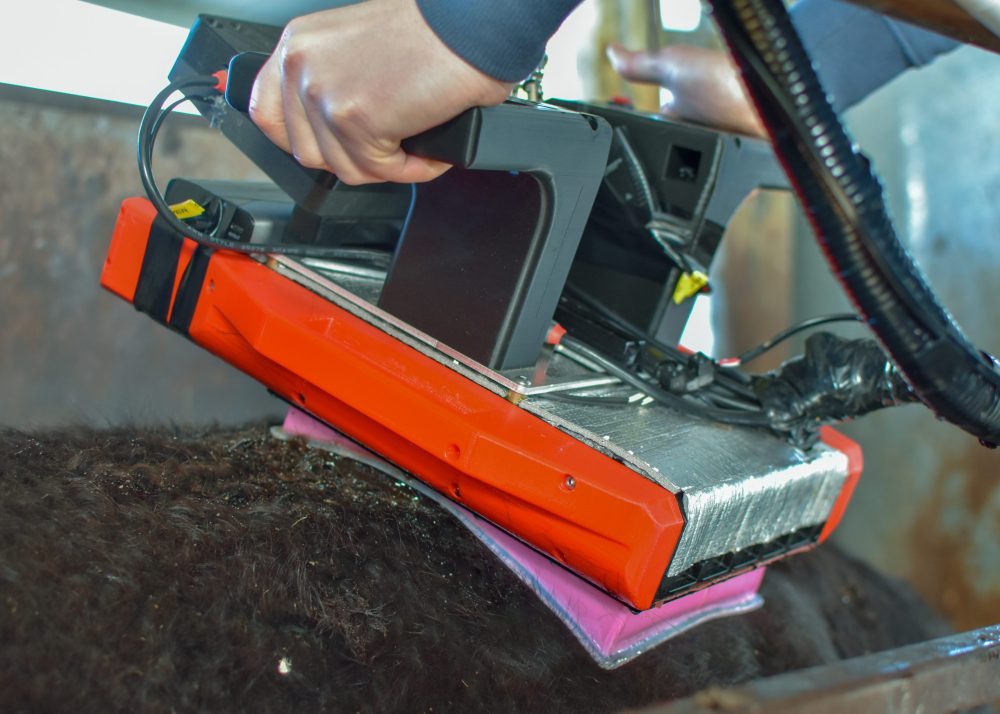MEAT science technology developer MEQ Probe has launched a new hand-held device that it says allows lotfeeders, cattle producers and saleyards operators for the first time to measure marbling in a live animal, in addition to providing an estimated meat yield.
Using proprietary ultrasound scanning and sophisticated machine learning technology, MEQ Live measures marbling and estimated yield in a beast before slaughter, providing the beef industry with data to help realise the optimal value for each animal.
The technology is designed for use in the race, at line speed, by a layman operator in a typical feedlot setting.
The developers claim the device has application right along the beef supply spectrum, from longfed, high marbling performance Wagyu and Angus, back to 60-70 day grainfed supermarket cattle.
Ultrasound was first developed for fat depth and pregnancy assessment in live cattle 20 years or more ago. Trials for marbling assessment at the time produced results described as ‘adequate’ rather than ‘spectacular’ – in fact the ultrasound technology developed something of a ‘stigma’ over its use in live animal assessment at the time, Beef Central was told.
However advances in both hardware and software had allowed MEQ to dramatically progress the use of ultrasound for the latest application. Part of this was about being able to extract more information per image, and developing novel ways to capture the data, Beef Central was told.
The new device also uses a combination of scans for rib fat depth and eye muscle area to deliver an estimated meat yield on the live animal. The accuracy of both yield and marbling were described as ‘statistically significant,’ in a given population of cattle.
Neither measurements are intended to replace objective or manual carcase assessment technologies already used in the abattoir, but simply to better manage cattle prior to slaughter.
In a statement, the company said the technology has been refined in partnership with grainfed beef supply chain manager Harmony Fine Foods in Victoria, where it has been used on Wagyu and Angus cattle for the past few months.
MEQ Probe chief executive Remo Carbone said the new live animal device provided an opportunity to know how much profit an individual animal was likely to bring ahead of processing, and drive more objective data back into breeding programs.
“Previously, a lotfeeder might have been managing a high-value Angus or Wagyu animal for several hundred days on feed, only to find out that the marbling and yield are not what they anticipated, bringing down profitability and making it difficult for them to fulfil an order,” he said.
The new MEQ Live tool would help eliminate this scenario, allowing accurate prediction of marbling and yield, he said.
“The insights that MEQ Live provides are the timely data that everybody across the beef supply chain needs,” Mr Carbone said.
Harmony Fine Foods chief executive Anthony Fellows said for years, a holy grail of beef production had been to objectively determine and predict the quality and yield in live animals.
“It just hasn’t been possible until now,” he said.
“MEQ Live has the potential to revolutionise how we do business, enabling us to map how feed types affect marbling performance and pick out the best animals for breeding. This technology also creates further sales opportunities by helping us to determine brand segmentation far in advance of traditional grading methods and being more environmentally friendly,” Mr Fellows said.
“The insights and data this technology provides is a treasure trove for the entire industry.”
Having marbling and yield insights at hand while animals are still alive brought significant benefits across the beef value chain, Mr Carbone said.
“Breeders, farmers, feedlot operators and saleyards operators will be able to use the data to fine-tune their feeding programs to optimise for the best eating quality, select prime cattle for breeding programs and understand how animals’ genetics drive future profitability.
“In turn, beef processors and brand owners can harness this data to forecast sales, optimise consistency and drive greater proof points to underpin their brands. It will also help discover new markets for existing products thanks to a greater knowledge of the beef available to be supplied.”
Carbon emissions reduction claims
The new live animal marbling and yield assessment device also provided an opportunity for the beef sector to become more environmentally efficient – and ultimately to do more with less, the statement suggested.
A report commissioned by MEQ Probe through carbon and sustainability consultancy, EnergyLink Services, found that the technology would have sustainability and environmental implications through optimisation of feedlot operations.
The report modelled emissions impacts through feeding to a ‘specification’, rather than days-on-feed. It found that the technology could result in 2.3 million tonnes of carbon dioxide equivalent direct emissions and indirect value chain reductions across Australian feedlot operations (currently joust over one million head on feed), equating to a 44pc overall reduction, the statement said.
The device also provided opportunity for measuring and verifying reductions in feed, carbon and water consumption of animals.
EnergyLink Services chief executive Philip Link said the emissions reduction potential of MEQ Live was significant.
“Australian agriculture is considered a ‘hard to abate’ sector, hence the innovation demonstrated by MEQ Probe has the potential to unlock abatement opportunities within and across a feedlot supply chain, thus propelling the sector towards a lower-carbon future,” he said.
- The new MEQ Live scanning device follows the launch of the developer’s existing MEQ Probe, a spectral analysis device used in hot carcase assessment by processors including Australian Country Choice and HW Greenham to verify eating quality from carcases during the production process.


Very interesting, would this capability ever become available for the use in Ovine.
Kind Regards Andrew
The more objectivity the better.
More accuracy of hitting the grid = more $
More accuracy in selecting breeding stock
Less running visual assessment workshops in the future!